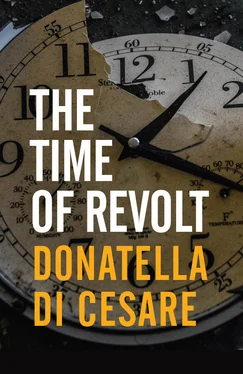It is, therefore, worth asking whether a politics outside this regimented and surveilled public space is possible. It had become difficult to act in this space even before it was occupied by the sovereign virus. To answer this question, we ought to reconsider the mechanism of public space and turn our gaze to the anarchist extra-politics which is preparing itself through the new revolts.
1 1 See Donatella Di Cesare, Immunodemocracy: Capitalist Asphyxia. Los Angeles: Semiotext(e), 2021.
2 2 Even Foucault tended towards such a view. See Michel Foucault, ‘Omnes et singulatim: Towards a Criticism of “Political Reason” [1979]’, in Power: Essential Works of Michel Foucault 1954–1984, Vol. 3. New York: New Press, 2000, pp. 298–325.
3 3 See Walter Benjamin, ‘Critique of Violence’, in Selected Writings, Vol. I: 1913–1926. Cambridge, MA: Harvard University Press, 2004, pp. 236–52.
The Constellation of Revolts
The highly fragmentary character of these revolts is one of their most striking features; it seems difficult even to get an overview of them. While there is no doubt as to their global reach, can we be similarly sure that they are all expressions of the one same phenomenon? Wouldn’t it be a bit of an exaggeration to use the same label for such disparate situations? Not least when we consider that, unlike the uprisings of the past, it is not easy to detect any shared aspiration in these revolts. If the insurgents of 1848 set their sights on liberty and the republic, if the revolutionaries of 1917 were guided by the twentieth-century ideal of communism, and if those who took to the streets in the 1960s and 1970s thought that another world was within reach, what unites the revolts of the twenty-first century?
One could emphasize the dissimilarities between these revolts and their discordant means of action and objectives. Some are episodic, others recurrent; some timidly raise their heads, whereas others are openly subversive. But to particularize the revolts, refusing to consider them as articulations of a global movement, amounts to taking the defence of the status quo at face value. It’s as if everything was fine – with just a few marginal problems springing up here and there.
When we point to the complicated connections between these revolts – their shifting affinities, their discontinuous movements, their countless correspondences – it may be useful to speak of a ‘constellation’. Distant stars in the night sky, scattered sparks that had earlier been hard to make out, suddenly cluster together. In this unprecedented arrangement, even the minor stars take on new value, as their previously hidden correspondence now stands out for all to see. There is no causal nexus, no linear direction, or even the semblance of a beginning. The constellation has no arché ; anarchic and subversive, it is the fluid outcome of an improvised mobilization that has torn through the homogeneous darkness. In their unexpected harmony, the individual lights grow more intense, lighting each other up, seeming to converge on one focal point. Their conjuncture now appears as an allegorical prefiguration.
Unsurprisingly, Walter Benjamin himself turned to the image of the constellation in his efforts to explode the monumental architectonics of the victors. This is the way to recover what has been erased, discredited, spat upon. That which is not granted historical dignity disrupts the flow of historical becoming. But just as stars die out and sink back into the impenetrable blackness of outer space, revolts, too, can dissolve into the abyss-like backdrop of history. This fiery interruption, almost a simultaneous conflagration, is the here and now of a present that risks escaping us unless it is read in good time. We thus need to keep a nocturnal watch over the sky of history – grasping revolts, calling them back to us and redeeming them with all their charge of disruption and salvation.
Anyone who wants to ascertain the common traits of the contemporary constellation of revolts, without losing sight of their local tendencies, has to accept a twofold challenge. The first lies in seeking out, if not their common thread, at least the string underlying them, bound together by the fact that so many fibres wrap around each other and form a pattern. The second demands attention to the kinetics of revolution, in which revolt occupies an important place but, equally, an enigmatic one. 4
The official news leaves revolt on the sidelines. If revolt does get past the censor, its power to stir sensation is transformed into spectacle and its transgressive obscurity put on display. It reaches our screens only as far as its gravity, urgency and dimensions warrant. Yet even when the revolt is hyper-visible and overexposed, it is condemned as senseless. There are marches, rallies, mobs in the street and, in a rising crescendo, columns of smoke, broken windows and cars and rubbish bins in flames. Whether in Portland or Baghdad, Athens or Beirut, Hong Kong or Algiers, Santiago or Barcelona, what emerges from the pictures is largely an image of disorder. The confusion of a chaotic, elusive event – that is what these portrayals insist on inferring from this disorder. Hence the lack of reflection on the question of revolt, which nonetheless beats the rhythm of our everyday existence.
If the news paints revolt in obfuscated, sinister colours – whipping up public disdain and fostering interpretative amnesia – this is because revolt extends beyond the logic of institutional politics. To be on the ‘outside’ is not to be politically irrelevant; this is precisely where revolt’s potential force resides, as it attempts to break into public space in order to challenge political governance on its own ground. It should come as no surprise that the version portrayed by the media and institutions relegates revolt to the sidelines, lessens its scope, scrubs it off the agenda and reduces it to nothing more than a spectre. Revolt thus appears as a disturbing shadow which haunts the well-surveilled borders of official current affairs.
For this reason, we need to change our perspective and look at revolt not from the inside – that is, from a stance within the state-centric order – but, rather, from the ‘outside’ in which it situates itself. Revolt is not a negligible phenomenon, nor is it the residue of the archaic, chaotic, turbulent past that linear progress is supposed to have refined and transcended. It is not anachronistic but anachronic, for it is the result of a different experience of time.
Revolt is a unique dimension of the global disorder – and offers a key to understanding an ever more indecipherable age. The explosions of anger are not lightning that strikes in a clear blue sky but, rather, a symptom, a wake-up call. If revolt is speaking about today, what does it have to say? How can and should it be interpreted? Modernity’s criteria no longer seem as valid as they once might have done. Cosmogonies on the meaning of history and totalizing dialectics no longer hold; they overlook the new political antagonisms, which remain unfathomed and impenetrable.
Connected to these questions is the relationship between revolt and politics. Contemporary revolt is generally considered pre-political, if not proto-political, insofar as – partly out of immaturity and partly out of a sort of verbal infantilism – it is unable to formulate authentic demands and hence organize itself into a system of proposals. This would imply that it is unpolitical, if we use this term to refer to its difficulties in entering the institutional political space. But, viewed from the opposite angle, revolt might better be described as hyper-political.
When we look at it more closely, contemporary revolt’s relationship with politics is not only a matter of provocation and conflict. The present-day political space is circumscribed by state borders, within which what happens is observed and judged. The modernity of the last two centuries has made the state into the indispensable means and supreme end of all politics. The ruling order is state-centric. The state’s undisputed sovereignty remains the criterion that plots the boundaries and draws the map of the present-day geopolitical topography. This has produced a separation between the internal sphere, which is subject to sovereign power, and the external sphere, which is consigned to anarchy. This commonplace dichotomy has introduced a value judgement that distinguishes an inside from an outside, civilization from barbarism, law from lawlessness, order from chaos. State sovereignty has imposed itself as the sole condition of order and the only alternative to anarchy – itself discredited as a simple lack of government, as the confusion that rages on the boundless outside. Yet, globalization has begun to undermine the dichotomy between sovereignty and anarchy, as it exposes all the limits of a politics anchored in traditional borders. If the state remains the epicentre of the new global disorder, the landscape on the other side of the border is now being populated by different protagonists. New phenomena such as migration are tearing open a gap that affords a glimpse of what is happening outside – obliging us to leave behind this dichotomy and embrace a new perspective.
Читать дальше












